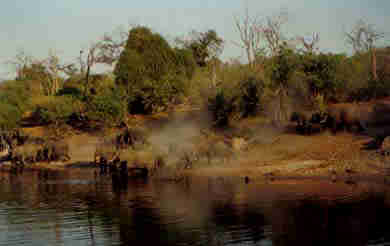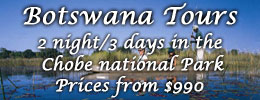Chobe National Park
 Chobe National Park is the second largest national park in Botswana. The 11.700 km² park is world-renowned for its wildlife and its 4 distinct ecosystems: in the north the Chobe Riverfront floodplains and teak forests, in the west the Savuti Marsh and in the north-west the Linyanti-swamps. These three ecosystems are separated by a fourth; the hot, dry hinterland.
Chobe National Park is the second largest national park in Botswana. The 11.700 km² park is world-renowned for its wildlife and its 4 distinct ecosystems: in the north the Chobe Riverfront floodplains and teak forests, in the west the Savuti Marsh and in the north-west the Linyanti-swamps. These three ecosystems are separated by a fourth; the hot, dry hinterland.
This diversity of habitat sustains a wide variety of animal species. This includes the water-loving hippos, crocodiles, otters and of course fish in the wetter regions. Elephant, buffalo, giraffe, zebra and sable antelope can be found at greater distances from the water. In all areas predators abound: lions, leopards, cheetahs and hyenas. Packs of wild dogs are occasionally sighted within the park.
The Chobe National Park is also famous for its magnificent bird life. Over 400 different species have been recorded, ranging from the majestic African Fish Eagle to various species of storks and the brilliantly coloured scarlet carmine bee-eaters. Occasionally the bee-eaters build colonies in the sandbanks of the Chobe River, where they gather and nest in their thousands, offering visitors a spectacular sight.
The premium spots for game viewing by our guests are the Chobe riverfront, the headwaters and the Ngwezumba River and Savuti.
The Chobe Riverfront stretches from Kasane through Serondela to Ngoma Bridge. In the late evenings, especially during winter, elephants come down to drink from the river their thousands. The riverfront is easily accessible to visitors, with the sandy river roads offering excellent wildlife viewing as well as spectacular scenery. While game viewing in this area is somewhat seasonal, due to larger mammals following grazing and rainfall patterns, there is such an abundance of game in the area that our safari guests are almost certain to see a good diversity at any time of year.







